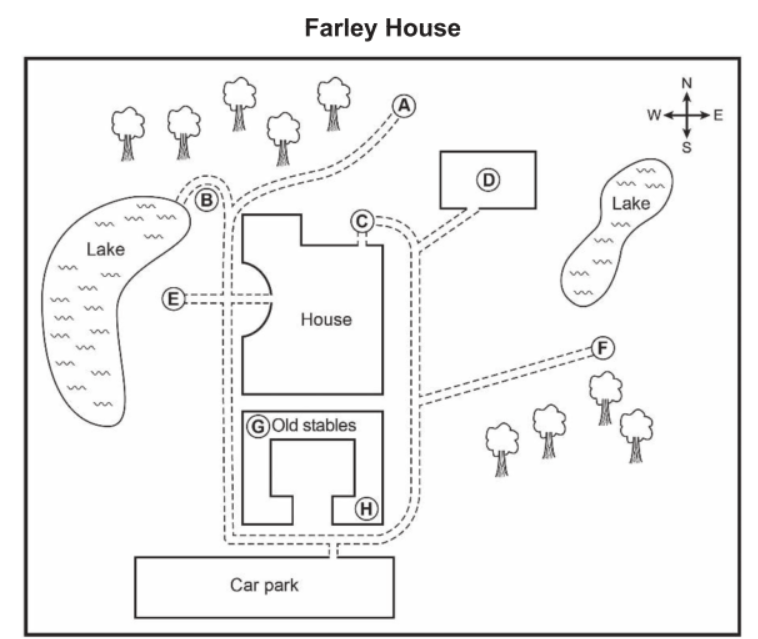Part 1: Questions 1-10
Complete the notes below. Write ONE WORD AND/OR A NUMBER for each answer.
The park
Area: (1) hectares
Habitats: wetland, grassland and woodland
Wetland: lakes, ponds and a (2)
Wildlife includes birds, insects and animals
Hinchingbrooke Country Park
Subjects studied in educational visits include
Science: Children look at (3) about plants, etc.
Geography: includes learning to use a (4) and compass
History: changes in land use
Leisure and tourism: mostly concentrates on the park’s (5)
Music: Children make (6) with natural materials, and experiment
with rhythm and speed.
Benefits of outdoor educational visits
They give children a feeling of (7) that they may not have elsewhere.
Children learn new (8) and gain self-confidence.
Practical issues
Cost per child: (9) £
Adults, such as (10) , free
Part 2: Questions 11-15
Choose the correct letter, A, B or C.
Stanthorpe Twinning Association
11. During the visit to Malatte, in France, members especially enjoyed
A going to a theme park.
B experiencing a river trip.
C visiting a cheese factory.
12. What will happen in Stanthorpe to mark the 25th anniversary of the Twinning Association?
A A tree will be planted.
B A garden seat will be bought.
C A footbridge will be built.
13. Which event raised most funds this year?
A the film show
B the pancake evening
C the cookery demonstration
14. For the first evening with the French visitors host families are advised to
A take them for a walk round the town.
B go to a local restaurant.
C have a meal at home.
15. On Saturday evening there will be the chance to
A listen to a concert.
B watch a match.
C take part in a competition.
Questions 16-20
Label the map below. Write the correct letter, A-H, next to Questions 16-20.
16. Farm shop
17. Disabled entry
18. Adventure playground
19. Kitchen gardens
20. The Temple of the Four Winds
Part 3: Questions 21 and 22
Choose TWO letters, A-E.
Which TWO things did Colin find most satisfying about his bread reuse project?
A receiving support from local restaurants
B finding a good way to prevent waste
C overcoming problems in a basic process
D experimenting with designs and colours
E learning how to apply 3-D printing
Questions 23 and 24
Choose TWO letters, A-E.
Which TWO ways do the students agree that touch-sensitive sensors for food labels could be developed in future?
A for use on medical products
B to show that food is no longer fit to eat
C for use with drinks as well as foods
D to provide applications for blind people
E to indicate the weight of certain foods
Questions 25-30
What is the students’ opinion about each of the following food trends? Choose SIX answers from the box and write the correct letter, A-H, next to Questions 25-30.
Opinions
A This is only relevant to young people.
B This may have disappointing results.
C This already seems to be widespread.
D Retailers should do more to encourage this.
E More financial support is needed for this.
F Most people know little about this.
G There should be stricter regulations about this.
H This could be dangerous.
Food trends
25. Use of local products
26. Reduction in unnecessary packaging
27. Gluten-free and lactose-free food
28. Use of branded products related to celebrity chefs
29. Development of ‘ghost kitchens’ for takeaway food
30. Use of mushrooms for common health concerns
Part 4: Questions 31-40
Complete the notes below. Write ONE WORD ONLY for each answer.
Ceide Fields
• an important Neolithic archaeological site in the northwest of Ireland
Discovery
• In the 1930s, a local teacher realised that stones beneath the bog surface were once (31)
• His (32) became an archaeologist and undertook an investigation of the site:
– a traditional method used by local people to dig for (33) was used to identify where stones were located
– carbon dating later proved the site was Neolithic.
• Items are well preserved in the bog because of a lack of (34)
Neolithic farmers
• Houses were (35) in shape and had a hole in the roof.
• Neolithic innovations include:
– cooking indoors
– pots used for storage and to make (36)
• Each field at Ceide was large enough to support a big (37)
• The fields were probably used to restrict the grazing of animals – no evidence of structures to house them during 38
Reasons for the decline in farming
• a decline in (39) quality
• an increase in (40)
1. 69/ sixty-nine
2. Stream
3. Data
4. Map
5. Visitors
6. Sounds
7. Freedom
8. Skills
9. 4.95
10. Leaders
11. B
12. A
13. B
14. C
15. A
16. G
17. C
18. B
19. D
20. A
21. B, D
22. B, D
23. A, E
24. A, E
25. D
26. G
27. C
28. B
29. F
30. H
31. Walls
32. Son
33. Fuel
34. Oxygen
35. Rectangular
36. Lamps
37. Family
38. Winter
39. Soil
40. Rain
